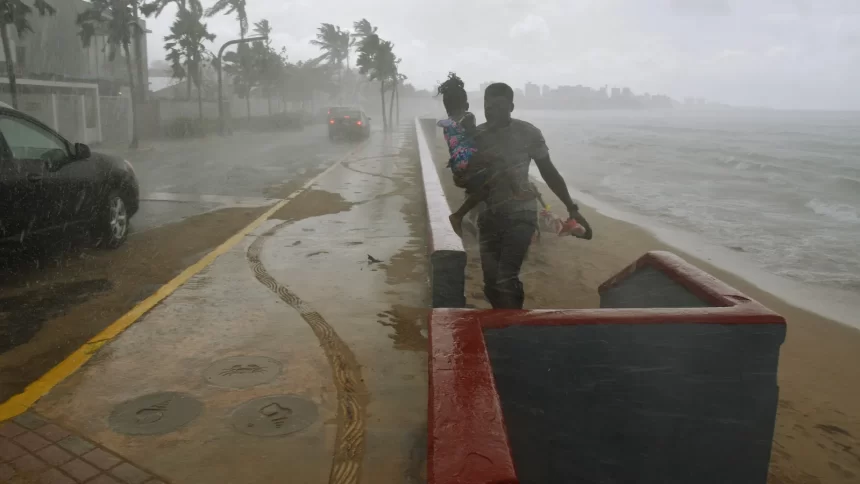As Hurricane Lee brought large swells and ferocious winds to batter the Caribbean islands, experts said the storm – which quickly and unexpectedly intensified into the highest category five strength – could be a sign of what’s to come as the world’s oceans warm up.
The hurricane, which reached 160mph (258km/h) winds on Friday (8 September), was a category one storm on Thursday but intensified to a category five, increasing by 85mph (137km/h) in just 24 hours. The increase made the hurricane, which meteorologists dubbed “rare”, the third-fastest rapid intensification in the Atlantic. According to the National Oceanic and Atmospheric Administration (NOAA), the definition of rapid intensification is a 35mph (56km/h) over a one-day period – which Lee greatly exceeded.
Only two other Atlantic hurricanes in history have intensified more rapidly – Felix in 2007, and Wilma in 2005 – and only 4.5% of named storms in the Atlantic have grown to a category five in the past decade.
Some climate scientists were stunned over not just Lee’s sudden intensification – and then rapid weakening – but also the timing of Jova, which rapidly ballooned into a category five storm as it made its way over the Pacific Ocean at the same time Lee was forming. These two huge storms formed as the US Atlantic hurricane season peaked on 10 September.
The increase in hurricane intensity is a harbinger of the future, according to Jeff Masters, a meteorologist at Yale Climate Connections (a Yale University-funded climate media forum) and former NOAA scientist. “We should expect more cases of rapid intensification as the climate continues to warm.”
Hugh Willoughby, research professor at Florida International University’s National Hurricane Research Center says a major hurricane intensifying rapidly isn’t out of the ordinary, as that’s just how they form – and the surprise is these hurricanes are happening during an El Niño.
“What’s weird is that there’s an El Niño going on, and normally an El Niño is a death on hurricanes – it prevents formation of really nasty hurricanes,” he says. “But the conventional wisdom is that this is [still happening] because the ocean is so hot, and that’s really interesting.”
There’s “pretty convincing evidence”, he adds, that major hurricanes are becoming more common.
Research has shown the proportion of tropical cyclones that reach category four and five is projected to increase due to global warming. Cyclones – or hurricanes, the term depends on their geographical location – form over warm sea surfaces; as water evaporates off the ocean’s surface, it rises as humid air, creating an area of lower air pressure below, causing more air to rush in, which in turn warms and rises. The air that rises eventually cools, forming clouds and thunderstorms, and a system that spins and grows, fed by the ocean’s heat and water evaporating from the surface. When wind speeds reach 74mph (119km/h), they’re classed as a hurricane or cyclone.
Since industrialisation, humans have been fuelling the rapid rise of greenhouse gases, which have increased the frequency and intensity of extreme weather events. And the costs, both on human life and the economy of extreme weather events, are rising.
You might also like:
- The high cost of an El Niño in 2023
- Florida’s first hurricane-proof town
- The US state pre-empting floods
“What we need to worry about are storms that become major hurricanes becoming more frequent and doing more damage,” adds Willoughby. “We have every reason to expect them to become more common, and it’s going to get worse.”
When hurricanes make landfall they begin to decrease in strength because they no longer gain energy from the ocean. However, they can still wreak devastation. When Hurricane Maria, a category five storm, hit the northeastern Caribbean in 2017, it killed as many as 4,600 people in Puerto Rico alone, causing power cuts, broken roads, and knocking out water services. It was the strongest hurricane to hit the island in a century.
In the Northwest Pacific, Hurricane Patricia, which hit in 2015, was the strongest landfalling Pacific hurricane on record. It was also the strongest storm in terms of wind speed, with winds of 214mph (345km/h). The death toll, almost unbelievably, was zero. The strongest Atlantic hurricane by wind speed was Hurricane Allen in 1980, which caused nearly 300 deaths in Haiti and whose winds reached 190mph (306km/h).
Economic harms – and billion dollar disasters – caused by extreme weather events are becoming more commonplace. Hurricane Katrina remains the costliest hurricane on record. The 2005 event, which destroyed more than 800,000 homes and brought catastrophic flooding to Louisiana, is estimated to have cost the US $193.8bn (£155bn).










